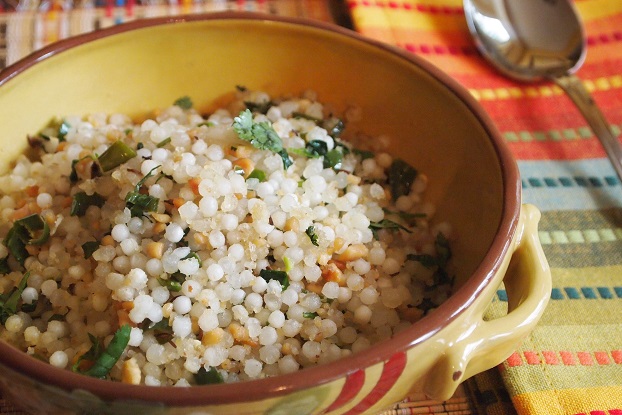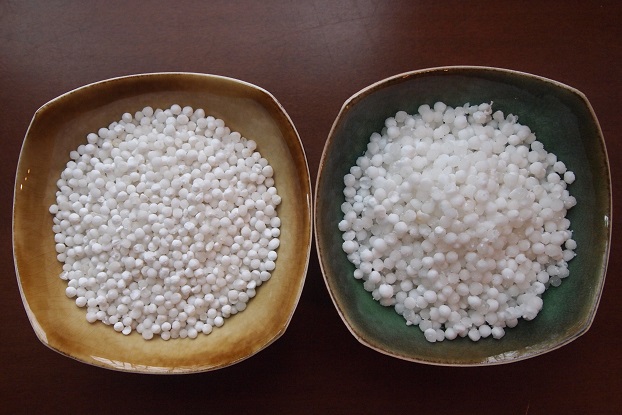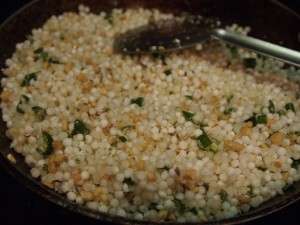
The idea that tapioca was a sick man’s food took shape in my brain during the growing years. Amar Chitra Katha comics, Chandamama, Enid Blyton, Nancy Drew, Hardy Boys and tapioca gruel were a sick girl’s die-hard companions. Easy to make and easy to digest, the gruel was not, unfortunately, very easy to eat. Looking back now, I realize it might have had more to do with the fevers, colds and the attendant loss of appetite, and not anything to do with the dish itself. On the couple of rare occasions when tapioca payasa (a type of pudding similar to the gruel) usurped the rightful place of other types of sweets at family celebrations, it was delicious.
Growing up in a South Karnataka/Tamil Nadu household, though, tapioca payasa and tapioca fritters (hand-crafted by my grandmother, my mom and aunts in their kitchens, dried on roof-tops and terraces during the searing hot summer months for use all through the year) were the only ways I’d ever seen tapioca pearls eaten.
Imagine my surprise when I got married and saw that there was an entirely new way of preparing tapioca pearls. Fresh green chilies, curry leaves, roasted and crushed peanuts, roasted cumin seeds, coriander leaves, salt, some sugar, and tapioca pearls soaked to divine plumpness — all coming together in a piping hot porridge that’s fluffy, not mushy. The whole thing is an elaborate scheme designed to make your senses come alive. And yes, a bowl scraped clean of the very last tapioca pearl is a sure sign you’re hale and hearty.
While eating the dish is a food-lover’s dream come true, learning to make it is a nightmare. It did not help my case at all that the tapioca we got at the Indian store near our home in the US was tired and jet-lagged from the trans-European and trans-Atlantic journeys it must have made to reach its final destination. The pearls were worn down to the point of disintegrating into powder.
In fact, a good quarter of the package was pulverized by the time we got our hands on it. So the result was that we got a mushy mess when we tried to soak the pearls in preparation for making the dish. If it wasn’t that, it was the other extreme — the pearls refused to soften. The outer layers would fall away into the soaking water and the inner core would be tough as stones.
The history of savory tapioca pearls in my American kitchen is marked with many disastrous and abandoned attempts, enough to make you want to throw in the towel and crawl into bed. In those early days, success was recalcitrant and fleeting. Learning to sift the pearls before using them and learning the right way to soak them for the right length of time were the toughest parts of the entire process; the rest of the method — including the spices and the actual cooking — was a breeze compared to the initial steps.

In the end, I realized there was no one method of getting the pearls to plump up in exactly the right way. Depending on how the dry pearls felt in my fingers when I first opened the package, they would either be soaked overnight (if they felt tough all around and did not threaten to disintegrate) or they’d be soaked for half-an-hour to an hour with regular splashes and turning over in between (if they felt weak and apt to crumble). If, by the time I was ready to cook, the pearls had not soaked the way I wanted them to, I’d even — horror of horrors — add water as it was cooking on the stove and the kichdi would turn out perfectly delicious. It was just a matter of knowing the consistency I wanted to achieve — perfectly seasoned, translucent pearls, moist but not mushy.
* * *
Recipe
Sabudana Kichdi (Savory Tapioca Pearls)
Makes 4 servings
Tempering:
3 tbsp oil
½ tsp cumin seeds
¼ tsp asafetida (see Tips and Notes below)
6 – 10 curry leaves
Ingredients:
3 cups tapioca pearls, soaked as explained below (also, see Tips and Notes)
6 green chilies (or to taste), chopped finely
Salt to taste (about 1 to 1½ tsp)
1 cup skinned and roasted peanuts, powdered coarsely (pulse the grinder or use a mortar and pestle to crush them until coarse; peanuts tend to become oily and clump together if ground too much)
3 tbsp chopped coriander leaves
3 tbsp fresh grated coconut (unsweetened) (optional)

Method:
Wash the tapioca thoroughly until the water runs clear and is not as cloudy as when you started. Pour the tapioca into a bowl, add enough cold water to submerge the tapioca fully. Make sure that none of the tapioca is left dry. Cover and let it soak for about an hour.
The tapioca will have completely absorbed all the water. Fluff the tapioca and make sure it’s softened well. It should give easily when you squeeze a pearl between your fingers but not disintegrate fully. Mix together the softened tapioca, the green chilies, salt (a little at a time, tasting the mix as you go along), and powdered peanuts. This is a good juncture for a final taste test. Adjust salt and chilies as necessary.
In a round-bottomed, heavy frying pan, heat the oil and add cumin seeds, asafetida (if using), and curry leaves and let roast for about ten seconds, until the cumin stops crackling. Add the tapioca mixture to the oil and mix thoroughly. Lower the flame and cook, covered, for about 15 minutes, stirring occasionally, until the tapioca is steamed and turns translucent.
Transfer to a serving bowl, garnish with coriander leaves and the coconut, if using.
Serving Suggestion:
Serve hot with your favorite chutney powder or a dollop of plain yogurt or both.
Tips and Notes:
1. The success of this dish depends entirely on the quality of the tapioca you find at your grocer’s. You could be faced with two problems — the tapioca could be too starchy (leading it to disintegrate when soaked in water) or it could fail to soften even when soaked overnight.
If it is too starchy (i.e., it comes apart easily when you press it), rinse the tapioca about an hour before cooking it and drain it thoroughly. Splash a handful of water once every fifteen minutes or so and stir the tapioca in the bowl carefully so you circulate the portion at the bottom to the top and vice versa. The tapioca has soaked enough if, when you pick up one pearl and squeeze it gently, it gives a little and its interior is no longer hard.
If the tapioca is tough and doesn’t give in even a little bit, rinse it thoroughly, add water, cover it and let it soak overnight. If it has failed to soften even when soaked this way, add tiny amounts of water (about ¼ cup) as it is cooking on the stove. (I must confess that this has happened very rarely though. Usually, I can get away with soaking it just for the hour before cooking.) Stir gently but thoroughly, cover the lid and let cook in the steam. Traditionalists may balk at this method, but it’s a good fix when the tapioca refuses to co-operate.
2. Green chilies can vary greatly in spiciness. Use fewer than suggested to begin with and work your way up to six chilies (and beyond) if you can enjoyably tolerate the heat.
3. Tapioca pearl packages advertise that they are gluten free. If you would like to make the entire dish gluten free, do not add the asafetida in the tempering. Asafetida contains wheat starch to make it flow easily.
* * *
Sujatha Bagal is a Washington, D.C.- based freelance writer and blogger. Her essays, articles and stories have appeared in various online and print publications, including Pregnancy, Mint Lounge, ForbesLife India and The Smart Set (links are available at http://blogpourri.blogspot.












